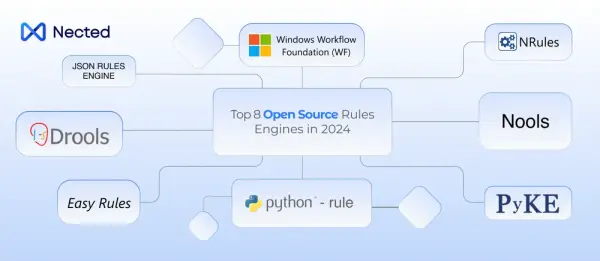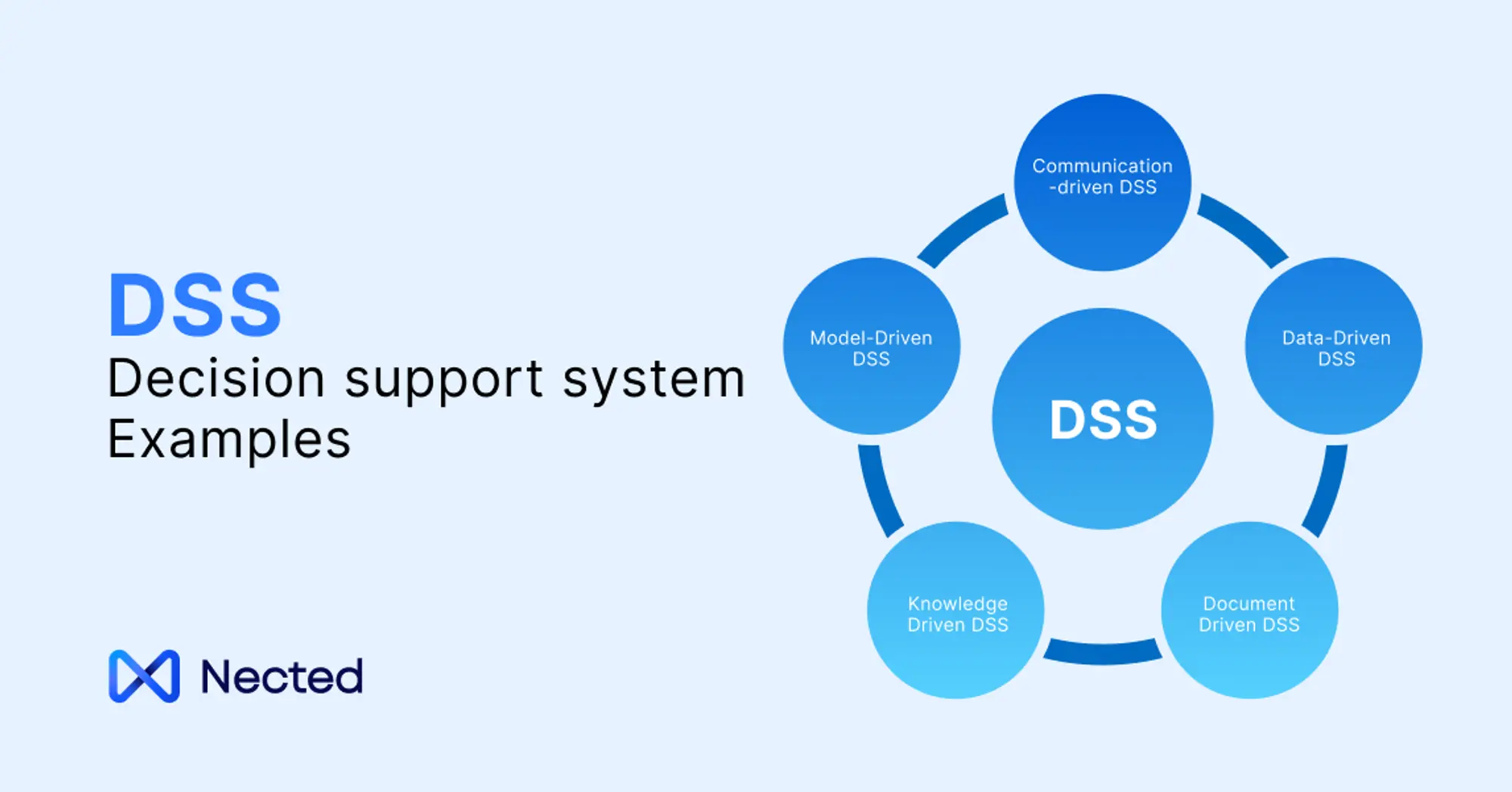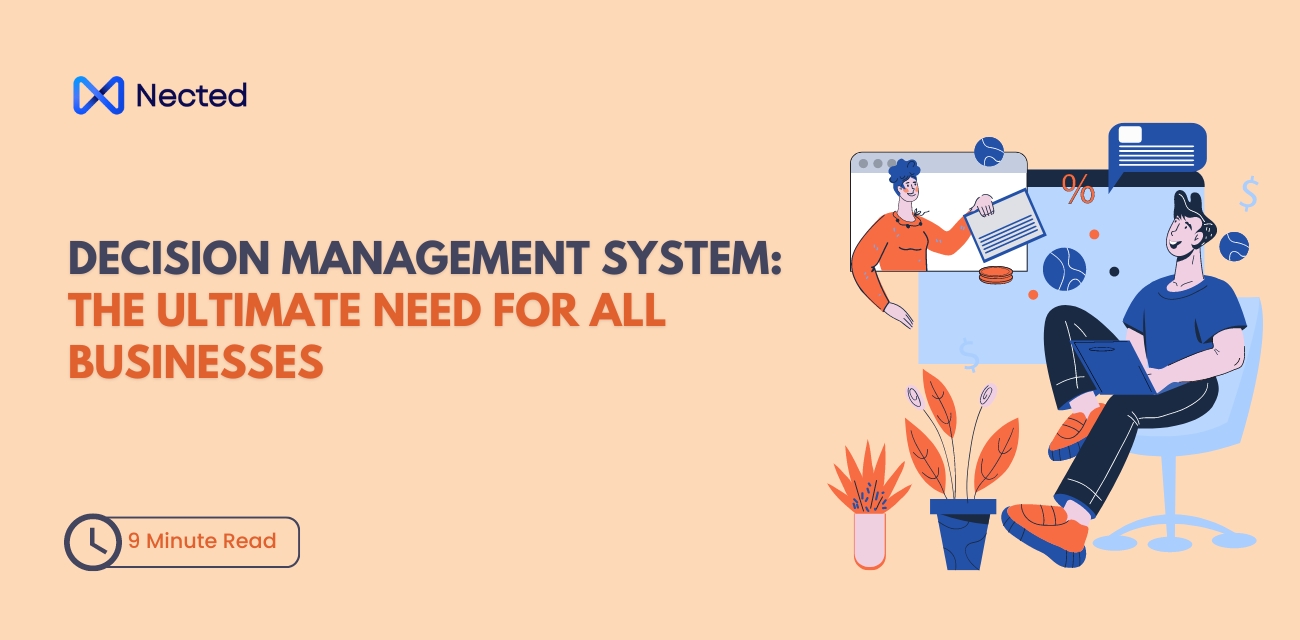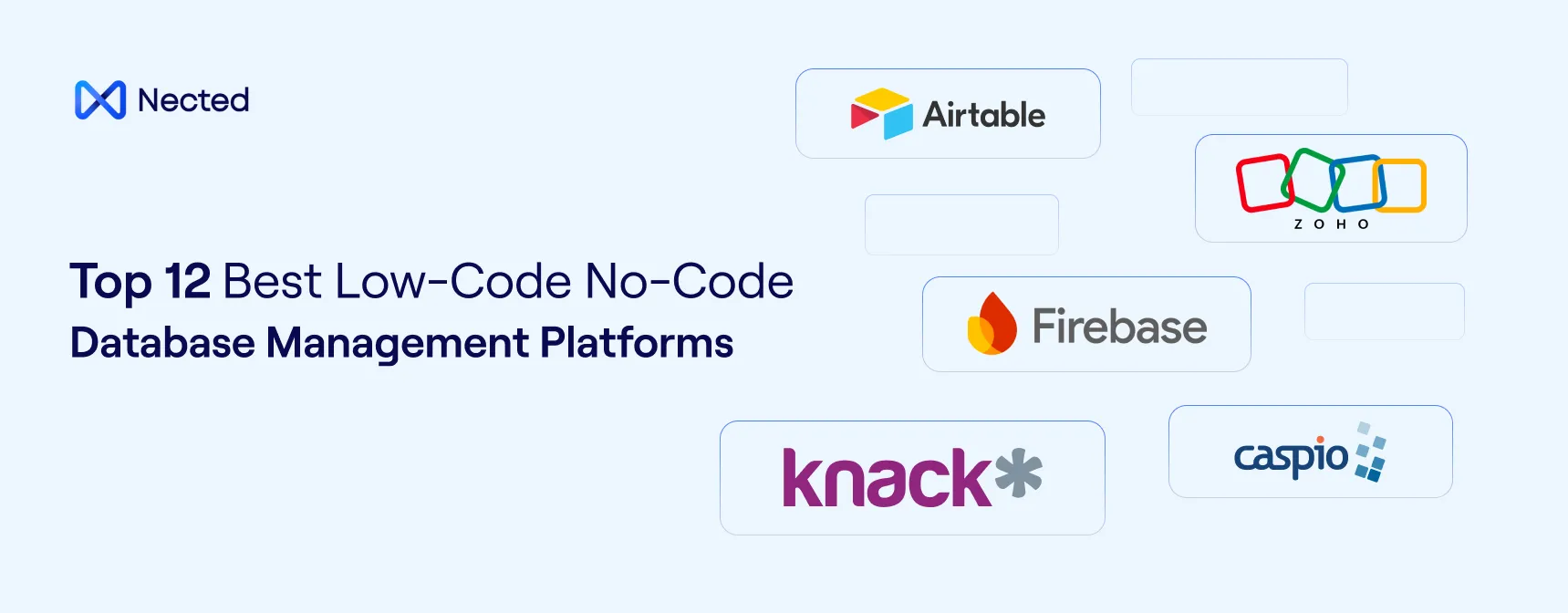Effective decision-making is a cornerstone of success in business and organizational environments. Navigating the complexities of modern data landscapes requires tools that provide timely and accurate insights. This is where Decision Support Systems (DSS) come into play. Designed to aid managers and decision-makers, DSSs are computer-based information systems that compile data, documents, personal knowledge, and business models. They support problem identification and decision-making processes, making them invaluable in today's data-driven world.
In this blog, we will talk about Decision Support Systems in detail. We will discuss their key characteristics, components, and various types, and provide real-world examples. Additionally, we will delve into the numerous benefits these systems offer, demonstrating their importance in enhancing decision-making efficiency and effectiveness.
What is a Decision Support System?
A Decision Support System (DSS) is a computer-based information system that supports business or organizational decision-making activities. DSSs help managers and other decision-makers compile useful information from raw data, documents, personal knowledge, and business models to identify and solve problems and make decisions.
DSSs are interactive software-based systems that help users analyze large volumes of information and access data from various sources to support semi-structured and unstructured decision-making. They provide an interactive interface that allows users to manipulate data, adjust parameters, and explore different scenarios. The primary purpose of a DSS is to assist decision-makers in making informed choices by providing relevant data, analyses, and insights. Below are the key characteristics of a DSS:
- Interactive: DSSs provide an interactive interface that allows users to manipulate data, adjust parameters, and explore different scenarios. This interactivity is essential for testing various hypotheses and understanding the potential outcomes of different decisions.
- Support for Decision-Making: The primary purpose of a DSS is to assist decision-makers in making informed choices. This support is provided through relevant data, analyses, and insights that help evaluate different options and select the best course of action.
- Modeling and Analysis: DSSs incorporate various models, algorithms, and analytical tools to process data and generate insights. These tools can include predictions, simulations, and optimization solutions that help understand complex situations and make better decisions.
- User-Friendly Interface: DSSs offer intuitive and easy-to-use interfaces, making them accessible to non-technical users. This user-friendliness ensures that decision-makers can effectively interact with the system and utilize its capabilities without needing extensive technical knowledge.
Components of a DSS
The key components of a Decision Support System (DSS) work together to give a comprehensive solution for accurate decision-making. These components include:
- Data Management: This component involves gathering, storing, and organizing relevant data from various sources. Efficient data management ensures that the DSS has access to accurate and up-to-date information, which is critical for making informed decisions.
- Modeling and Analysis Tools: DSSs use models, algorithms, and analytical techniques to process data and generate insights. These tools help in transforming raw data into meaningful information that can be used for decision-making.
- User Interface: The user interface presents data, visualizations, and results in a user-friendly manner. It enables users to interact with the system, input data, and view the analysis results, facilitating an effective decision-making process.
- Database Management System (DBMS): The DBMS manages the storage and retrieval of data for the DSS. It ensures that data is stored securely and can be accessed quickly when needed, supporting the overall functionality of the system.
- Knowledge Base: The knowledge base stores domain-specific knowledge, rules, and guidelines that support decision-making. This component provides the DSS with the contextual information needed to interpret data and generate relevant insights.
- Communication and Collaboration Tools: These tools enable the sharing of information, analysis results, and scenarios among team members. Effective communication and collaboration are essential for ensuring that all stakeholders are involved in the decision-making process and can contribute their expertise and perspectives.
Decision Support Systems are essential tools that enhance decision-making by providing interactive, data-driven, and user-friendly solutions. By understanding their characteristics and components, organizations can leverage DSSs to make more informed and effective decisions.
Suggested Read: Enhanced Techniques of Decision Making using Nected’s Empowering Solutions
What are the types of Decision Support Systems?
Decision Support Systems (DSS) are categorized based on the nature of the support they provide and the methods they employ. Understanding the different types of DSS helps organizations choose the right system to meet their specific decision-making needs. Here are the primary types of DSS:
1. Document-Driven DSS
Document-Driven Decision Support Systems focuses on managing and providing access to textual information that is crucial for decision-making. These systems organize and retrieve documents such as reports, research papers, and policy documents. By leveraging document management technologies, a Document-Driven DSS ensures that decision-makers have easy access to necessary information. Legal advisory systems where lawyers need to quickly find relevant case laws and legal documents to support their arguments.
2. Data-Driven DSS
Data-Driven Decision Support Systems emphasize the analysis and visualization of data to aid decision-making. These systems use data from internal and external sources to generate insights. They often employ business intelligence tools and data visualization techniques to help users identify patterns, trends, and relationships in large datasets. Business intelligence platforms that analyze sales data to identify market trends and forecast future sales.
3. Knowledge-Driven DSS
Knowledge-Driven Decision Support Systems incorporate expert knowledge and rules to support decision-making processes. These systems leverage artificial intelligence and machine learning to provide recommendations based on domain-specific knowledge. They are particularly useful in areas where decision-making relies heavily on expertise and established guidelines. Medical diagnosis systems that provide treatment recommendations based on patient symptoms and historical medical data.
4. Model-Driven DSS
Model-Driven Decision Support Systems rely on mathematical and analytical models to support decision-making. These systems use models such as financial forecasts, optimization models, and simulation tools to analyze complex scenarios and predict outcomes. Model-driven DSSs are valuable in situations that require detailed quantitative analysis. Financial planning tools that help organizations create budgets and perform scenario analysis to understand potential financial outcomes.
5. Communication-Driven DSS
Communication-Driven Decision Support Systems focus on enabling collaboration and communication among team members to support decision-making. These systems provide tools for sharing information, discussing options, and collectively making decisions. Communication-driven DSSs are essential for facilitating teamwork and ensuring that all stakeholders are involved in the decision-making process. Collaboration platforms that enable remote teams to share project updates, discuss strategies, and make collective decisions.
Organizations can select the most appropriate DSS to address their specific decision-making needs. Each type offers unique capabilities and benefits, enhancing the overall effectiveness of the decision-making process.
Suggested Read: Implementing Automated Decision Management Software for Regulating Industries
Decision Support System Examples
DSS provide critical assistance across various industries by offering data-driven insights and aiding complex decision-making processes. Here are some notable decision support system software examples:
1. Sales Forecasting
Sales forecasting DSSs analyze historical sales data, market trends, and other influential factors to generate accurate sales predictions. These systems help organizations plan their sales strategies, allocate resources effectively, and set realistic sales targets.
A retail company uses a DSS to forecast holiday season sales by analyzing past sales data, current market trends, and promotional impact. This helps the company optimize inventory levels and schedule staffing accordingly.
2. Inventory Management
Inventory management DSSs assist organizations in optimizing their inventory levels. By analyzing demand patterns, lead times, and other variables, these systems help make informed decisions about ordering, stocking, and distribution, ensuring a balance between inventory costs and availability.
An e-commerce platform uses a DSS to monitor inventory levels in real-time, predict future stock requirements based on historical sales data, and automate reorder processes to prevent stockouts or overstocking.
3. Financial Planning and Analysis
Financial planning and analysis DSSs support financial modeling, budgeting, and scenario analysis. These systems help organizations evaluate financial performance, plan budgets, and analyze the impact of different financial strategies on their overall goals.
A manufacturing company employs a DSS to create detailed financial models for budgeting. The system simulates various economic scenarios, helping the company prepare for potential market fluctuations and make strategic financial decisions.
4. Supply Chain Optimization
Supply chain optimization DSSs enhance the efficiency of supply chain operations by analyzing logistics, transportation, and supplier performance data. These systems help organizations make informed decisions about sourcing, distribution, and inventory management, leading to cost savings and improved service levels.
A global logistics provider uses a DSS to optimize its supply chain routes by analyzing data on transportation costs, delivery times, and supplier reliability. This enables the provider to choose the most efficient routes and improve delivery performance.
5. Healthcare Decision Support
Healthcare DSSs aid medical professionals in making clinical decisions by providing access to patient data, treatment guidelines, and predictive analytics. These systems support diagnosis, treatment planning, and patient management, leading to improved patient outcomes.
Like, a hospital uses clinical decision support tools to assist doctors in diagnosing diseases. The system analyzes patient symptoms, medical history, and current treatment guidelines to recommend potential diagnoses and treatment plans, enhancing the accuracy and speed of medical decisions. Examples of clinical decision support tools include BMJ Best Practice, DynaMed, UpToDate, RAMPmedical's therapy decision support platform, Medical Algorithms Company's evidence-based analytics, and Cohesic's guided clinical workflows.
So, these are the applications of Decision Support Systems across different sectors. By leveraging DSSs, organizations can enhance their decision-making processes, leading to better outcomes and increased efficiency.
Best Decision Support System Examples by Industry
| Industry |
Use Case |
Outcome |
| Healthcare |
Clinical decision support for diagnosis and treatment planning |
Improved patient outcomes and reduced diagnostic errors |
| Finance |
Risk analysis for investment portfolios |
Enhanced portfolio performance and minimized financial risk |
| Retail |
Demand forecasting and inventory optimization |
Reduced stockouts and improved supply chain efficiency |
| Manufacturing |
Production scheduling and resource allocation |
Increased operational efficiency and lower production costs |
Suggested Read: Rule Engine for Healthcare: Transforming Medical Decision-Making
Clinical Decision Support System Examples
In healthcare, Clinical Decision Support Systems (CDSS) are designed to improve patient outcomes by providing healthcare professionals with data-driven insights. These systems analyze patient data, medical knowledge, and clinical guidelines to assist in making timely and accurate decisions. Here are a few examples:
- Diagnostic Assistance Systems: These systems analyze patient symptoms, history, and test results to suggest possible diagnoses. They provide doctors with a list of probable conditions based on the data input, helping to avoid misdiagnosis.
- Electronic Prescription Tools: CDSS can evaluate patient data—like allergies, ongoing treatments, and medical history—to recommend or warn against specific medications. This reduces the risk of adverse drug interactions or allergies.
- Chronic Disease Management: CDSS tools help monitor chronic conditions such as diabetes or hypertension by tracking patient vitals over time. Based on real-time data, the system can recommend adjustments in treatment plans or medication dosages.
- Radiology Decision Support: By comparing current imaging with historical data and clinical guidelines, CDSS assists radiologists in identifying abnormalities and making more accurate diagnoses from CT scans or MRIs.
These systems don’t replace healthcare professionals but work alongside them to provide more comprehensive care, minimize errors, and optimize clinical workflows.
Example of Decision Support System in Business
Decision Support Systems in business are critical for managing data and transforming it into actionable insights that improve operations and strategic planning. Here are some practical examples:
- Inventory Management Systems: These DSS tools help businesses manage stock levels by analyzing demand patterns, lead times, and supplier performance. They assist decision-makers in restocking at optimal times, ensuring there’s neither an overstock nor a shortage.
- Financial Forecasting Tools: DSS tools can process vast datasets related to market trends, sales, and financial performance to help businesses forecast revenue, identify potential risks, and create budgets.
- Customer Relationship Management (CRM) Systems: CRM DSS can analyze customer behavior, sales data, and marketing trends to offer insights into customer preferences. Businesses use this data to personalize marketing efforts, predict future sales, and improve customer retention.
- Human Resource Management Systems (HRMS): DSS in HRMS assists HR professionals in decision-making related to recruitment, employee performance, and succession planning by analyzing employee data and market trends.
These examples demonstrate how DSS provides businesses with the analytical capabilities needed to make informed decisions that optimize operations and increase profitability.
Components of Decision Support System
A Decision Support System consists of several key components that work together to provide decision-makers with data-driven insights:
- Database Management System (DBMS): The DBMS stores all the relevant data needed for decision-making. This can include internal data from company operations and external data like market trends or industry reports.
- Model Management System (MMS): This component contains mathematical and analytical models that process the data. These models can range from simple spreadsheets to complex algorithms designed for forecasting, optimization, or risk analysis.
- User Interface (UI): The UI allows users to interact with the DSS. It provides an easy-to-navigate platform where users can input data, access reports, and view recommendations in a clear, understandable format.
- Knowledge Base: In more advanced DSS, especially in areas like healthcare, there is a knowledge base containing rules, guidelines, and expert knowledge that enhances the decision-making process.
- Communication Subsystem: This allows the DSS to interface with external systems and share information, ensuring data from multiple sources can be integrated and used in decision-making.
These components work in unison to provide users with comprehensive, data-driven insights that support efficient decision-making processes.
Suggested Read: Top 10 Decision Intelligence Platforms you should know
What is Decision Support System in Business Intelligence?
A Decision Support System (DSS) in Business Intelligence (BI) is a powerful tool that enables organizations to transform raw data into meaningful insights that drive strategic decisions. In the context of BI, DSS goes beyond basic data collection and reporting; it integrates various data sources, applies sophisticated analytical models, and presents the results in an easily understandable format, such as interactive dashboards, reports, or visualizations. The primary goal is to help businesses make informed, data-driven decisions that improve performance and competitive advantage.
Here’s how a DSS works within a BI framework:
- Data Collection and Integration: DSS systems in BI pull data from multiple sources—internal databases, external market data, customer information systems, and even unstructured data such as social media content. This ability to gather and consolidate data from various channels creates a comprehensive dataset that allows businesses to get a 360-degree view of their operations. The system ensures that the data is clean, consistent, and ready for analysis.
- Data Processing and Analysis: Once the data is collected, the DSS processes it using advanced analytics techniques such as data mining, machine learning, and statistical analysis. These techniques identify trends, patterns, and anomalies that may not be immediately apparent through manual analysis. In some cases, the system may also apply predictive models to forecast future outcomes or scenarios, providing businesses with insights into what might happen under different circumstances.
- Modeling and Simulation: One of the key components of a DSS in BI is the ability to run simulations or "what-if" scenarios. By using mathematical models, businesses can simulate different decisions or strategies to see how they would impact outcomes. For instance, a business can use DSS to model how changes in pricing, supply chain operations, or marketing strategies could affect profits, customer satisfaction, or market share. This helps decision-makers evaluate potential outcomes before making significant changes.
- Real-Time and Historical Data: DSS in Business Intelligence combines both real-time and historical data, providing a comprehensive picture of the business's current state while also offering a long-term view based on past performance. Real-time data helps businesses respond quickly to immediate needs, such as shifts in market demand or sudden supply chain disruptions. Historical data, on the other hand, helps businesses understand long-term trends and evaluate the effectiveness of past decisions.
- Improving Business Agility: In a rapidly changing business environment, agility is key to staying competitive. A DSS in BI allows organizations to respond quickly to market changes, customer preferences, or operational disruptions. Whether it’s adjusting production levels in response to supply chain delays or altering marketing strategies based on real-time customer feedback, a DSS provides the information needed to make swift, informed decisions.
So, a DSS within a Business Intelligence framework not only helps businesses understand what happened and why but also predicts what could happen in the future and prescribes the best course of action. By leveraging data in this way, businesses can significantly enhance their decision-making capabilities, reduce uncertainty, and improve their overall efficiency and profitability.
Key takeaways:
- A DSS in BI consolidates disparate data sources for a 360-degree business view.
- Predictive modeling enables businesses to simulate outcomes before implementation.
- Real-time analytics help organizations respond instantly to operational challenges.
- Using DSS in BI can reduce decision-making time by up to 40% in fast-paced industries.
Conclusion
Decision Support Systems (DSS) are indispensable tools that empower organizations to make informed, efficient, and strategic decisions. By integrating data, models, and user-friendly interfaces, DSSs provide critical insights that enhance decision-making processes across various domains. From sales forecasting and inventory management to financial planning and healthcare, the applications of DSSs are diverse and impactful.
Understanding the different types of DSS—Document-Driven, Data-Driven, Knowledge-Driven, Model-Driven, and Communication-Driven—enables organizations to select the most suitable system for their needs. The benefits of implementing DSSs are substantial, including improved decision-making, enhanced efficiency, increased competitiveness, better risk management, and improved collaboration.
As businesses navigate the complexities of the modern data landscape, adopting Decision Support Systems can be a game-changer. By harnessing the power of DSSs, organizations can achieve greater accuracy, speed, and effectiveness in their decision-making processes, ultimately driving success and growth.
FAQs
Q1. What is a Decision Support System with Examples?
A Decision Support System (DSS) is a computer-based information system that supports business or organizational decision-making activities. DSSs are designed to help managers and other decision-makers compile useful information from a combination of raw data, documents, personal knowledge, and business models to identify and solve problems and make decisions
.Some examples of DSSs include:
- Sales Forecasting: DSSs can analyze historical sales data, market trends, and other factors to generate accurate sales forecasts to support strategic planning and decision-making.
- Inventory Management: DSSs can help organizations optimize their inventory levels by analyzing demand patterns, lead times, and other variables to make informed decisions about ordering, stocking, and distribution.
- Financial Planning and Analysis: DSSs can assist in financial modeling, budgeting, and scenario analysis to support financial decision-making and strategic planning.
- Supply Chain Optimization: DSSs can help organizations optimize their supply chain operations by analyzing data on logistics, transportation, and supplier performance to make informed decisions about sourcing, distribution, and inventory management.
- Healthcare Decision Support: DSSs can aid medical professionals in making clinical decisions by providing access to patient data, treatment guidelines, and predictive analytics to support diagnosis, treatment planning, and patient management.
Q2. What is an Example of a Group Decision Support System?
A Group Decision Support System (GDSS) is a type of DSS that facilitates decision-making by a group of participants. One example of a GDSS is the use of a decision room, which combines face-to-face interactions with technology. Using networked computers and projectors, multiple participants can interact with the same information simultaneously, such as entering feedback on documents shown on the screen. Collaborative software is used to process this feedback into meaningful information. Another example of a GDSS is the Delphi approach, which is a structured communication technique in which experts answer questionnaires in several rounds. Participants get to see each other's input after each round and are encouraged to revise their earlier answers based on replies from others. The underlying assumption is that this type of communication will lead to a convergence toward a final answer.
Q3. What is a Support System Example?
Some other examples of support systems include:
- GPS route planning: Determines the fastest and best route between two points by analyzing and comparing multiple possible options, and can also include traffic avoidance capabilities that monitor real-time traffic conditions.
- Crop planning tools for farmers: Used to determine the best time to plant, fertilize, and reap.
- Medical diagnosis software: Allows medical personnel to diagnose illnesses.
- Descriptive analytics: Metrics such as sales results, inventory turnover, and revenue growth that report past performance.
- Diagnostic analytics: Information that digs deeper to reveal results and explain reasons for past performance.
- Business intelligence (BI): Although largely based on historical data, BI solutions allow users to develop and run queries that are used to guide and support decision-making.
These support systems, whether decision-support systems or other types share the common goal of providing information and insights to aid decision-making processes.
Q4. What is a Decision Support System, and how does it work?
A Decision Support System (DSS) is a software tool designed to assist in making informed decisions by analyzing data and presenting actionable insights. It typically uses models and data processing to provide recommendations or forecasts.
Q5. What industries commonly use Decision Support Systems?
DSS is widely used across industries such as healthcare, finance, retail, manufacturing, and human resources. Any field that requires data-driven decision-making can benefit from a DSS.
Q6. Can a Decision Support System replace human decision-making?
No, DSS is not meant to replace human decision-making. It acts as a tool to aid decision-makers by providing data-driven insights. Human judgment is still essential in interpreting the results and making final decisions.
Q7. How do Decision Support Systems improve efficiency in business?
DSS improves business efficiency by automating data analysis, minimizing human error, optimizing decision-making processes, and providing quick access to actionable insights.
Q8. What are the limitations of Decision Support Systems?
The main limitations include the need for accurate, up-to-date data for effective performance and the fact that they require significant resources to develop and maintain. Additionally, the system's recommendations can only be as good as the models and algorithms used.



.png)
.svg)
.webp)






.svg)






.webp)
.webp)

.webp)


.svg)





.webp)
.svg.webp)











.webp)


%20m.webp)
.webp)


.webp)
.webp)






%20(1).webp)
